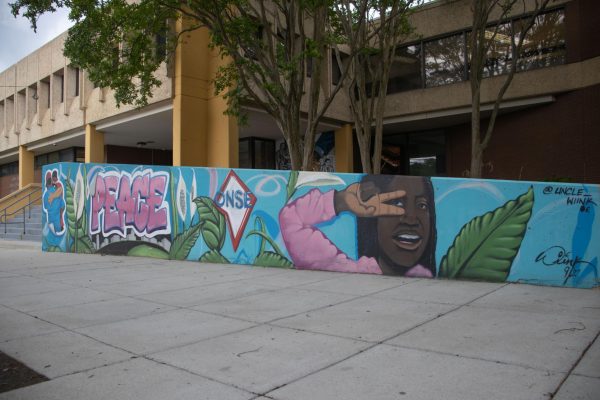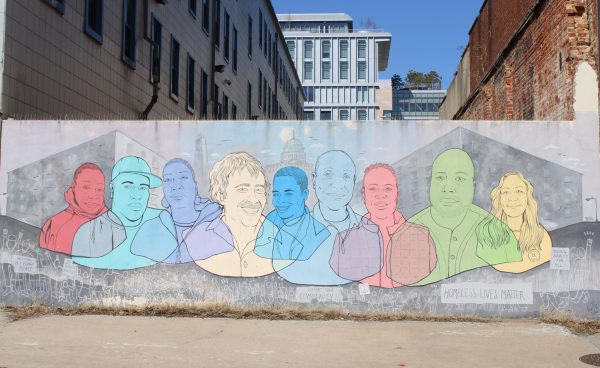An Epidemic: The Effect of HIV/AIDS on D.C.’s Homeless
Originally published in Spring 2017, Issue 21.
In 1998, Wayne Turner, longtime HIV/AIDS activist, lost his partner Steve Michael to AIDS. Turner brought Michael’s body to the White House as an act of protest in 1998. Before his death, Michael requested a political funeral outside the White House to protest the Clinton administration’s ineffective AIDS policies.
D.C.’s–and America’s–AIDS problem was on display for the world to see.
According to the D.C. Department of Health, one in 40 people in the District are HIV positive, 6.4 times more than the national average. But HIV isn’t D.C.’s only epidemic. Homelessness in D.C. is twice the national average: about three of every 200 people in the District are homeless.
“I think that housing is an essential health right, as is access to medical care,” said Turner, now a lawyer at the National Health Law Program. He went to law school after Michael’s death to become a more effective activist.
An HIV diagnosis increases the risk of homelessness, especially when treatment access is limited. According to the National Alliance to End Homelessness in 2006, approximately 3.4 percent of people who are homeless are HIV positive, about three times higher than the national percentage at the time.
Without consistent treatment, an HIV positive person will become sick more often. As a result, they may miss work because they’re sick and be unable to afford rent. If someone becomes homeless, their chance of getting treatment drops dramatically.
“D.C. has been kind of a mixed bag with how well our safety net has been operating. There are endemic problems with people falling through the cracks,” said Turner.
Treatment and prevention resources are more accessible in D.C. than in most of the country, largely because of efforts from the local government and NGOs over the last several decades.
“Most people that we’ve interviewed [in my D.C. research] have already had an HIV test… over 80 percent,” said Dr. Nina Yamanis, an American University international service professor who studies HIV in D.C.
“And I think that’s not the case in other parts of the country where there [are fewer] good NGOs that do HIV testing and outreach.”
However, Yamanis said gentrification is pushing low-income, high-risk individuals out of their housing in the district and into the suburbs, where treatment facilities are few and far between.
“People come from outside the District for services, but they may not have the same resources that people that live in the District have. And who can really afford to live in the District anymore?” she said. “If you don’t live in the District, you aren’t eligible for D.C. Health[care] Alliance.”
D.C. Healthcare Alliance provides medical assistance for low income D.C. residents who are not eligible for Medicaid or Medicare.
“The Alliance even covers undocumented people,” Yamanis said.
Despite the Alliance’s success in D.C., not all government programs are helping HIV positive people the way they were designed to. HOPWA, Housing Opportunities for Persons with HIV/AIDS, is an example.
HOPWA was created as a part of the U.S. Department of Housing and Urban Development in 1992 and addresses the unmet housing needs for people with HIV/AIDS.
“HOPWA money was designed for people who die while they were sitting on the housing waiting list for a Section 8 voucher,” said Turner. “In all my years as an HIV/AIDS activist — since the 1980s — I have never met anyone with HIV that has actually gotten HOPWA housing.”
“Although there are programs and services, a lot of times they get buried in bureaucracy and poor implementation,” he said.
“This is a hugely complex system. No wonder people have trouble negotiating.”
Turner explained that without dependable transportation or phone access, someone may be unable to go to government offices to apply for HOPWA. These offices often have long wait times, which can prevent potential applicants from making it to work. All of these factors, combined with an HIV positive person’s higher likelihood of becoming sick, contribute to an increased risk of losing housing. This system also makes it more difficult for the homeless to regain housing.
Health care access has long been a huge obstacle for HIV positive people. However, with the expansion of Medicaid through the Affordable Care Act (ACA), qualifying for care as an HIV positive person became much easier.
“Medicaid is the great equalizer. In the earlier days of the epidemic, people would test positive, spend all their savings, and in the end, everyone would end up on public benefits,” Turner said. His late partner was on public benefits at the time of his death.
“In order to qualify for Medicaid before the ACA, you had to have an AIDS diagnosis. People with HIV couldn’t qualify,” he added.
Today, an HIV positive diagnosis does not disqualify someone from Medicaid as it did in the past. Therefore they can access antiretroviral therapy and control their viral load to avoid full-on AIDS, and prevent infection of anyone else.
Between the government, NGOs, student groups, advocacy organizations, and social enterprises, D.C.’s rates of new HIV infections are declining. This decline can partly be attributed to needle exchange programs for intravenous drug users.
According to the CDC, HIV is primarily transmitted through unprotected sex with an HIV positive partner or through sharing needles. Populations at highest risk include sex workers, intravenous drug users, men who have sex with men, and LGBTQ+ persons, especially black gay and bisexual men.
LGBTQ+ youth in particular face specific challenges when it comes to HIV, explained Deondre Moore, an activist and student at Sam Houston State University.
“Sex work can be a main source of living for LGBT[Q+] kids if they’re kicked out [of their parents’ homes],” Moore said. “When our youth are put out by their parents and they don’t have a place to live, they’re forced to engage in sex work and aren’t able to have access to treatment and prevention,” he added.
Treatment and prevention, as Turner explains, often go hand in hand.
“What D.C. has projected as its goal… is get 90 percent of its HIV positive population in treatment,” Turner said. “That’s the pitch now: treatment is prevention. That goal is not going to happen without a robust Medicaid program that’s working to serve clients.”
Until 2007, Congress blocked D.C. municipal funding for needle exchange programs, which are proven to reduce transmission of HIV. New cases of HIV from needle sharing dropped 70 percent after needle exchange program implementation in 2008, according to a study published in the scientific journal AIDS and Behavior.
“We have all these initiatives and clinics and organizations, but why are rates [of HIV infection] still so high? D.C. is absolutely representative of the nation in that sense,” said Moore.
Regardless, D.C. has a long way to go.
“These aren’t simple problems, but having a report and setting a numerical goal does not solve the problem,” Turner said.
D.C. Mayor Muriel Bowser has a plan to get 90 percent of HIV positive people into treatment.
“Treatment adherence is tough when you don’t have a roof over your head,” Turner said.
Miranda Cleland is a senior studying international relations and Arabic studies.






